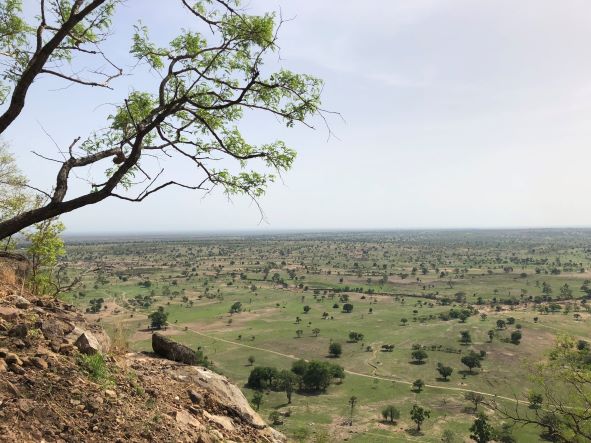Documentation of Nyesam

Landing page image for the collection ‘Documentation of Nyesam’. Click on image to access collection.
| Language | Nyesam |
| Depositor | Eveling Villa, Dmitry Idiatov |
| Affiliation | INALCO, LLACAN, CNRS |
| Location | Nigeria |
| Collection ID | nyesam-villa-0660 |
| Grant ID | |
| Funding Body | INALCO, LLACAN, CNRS |
| Collection Status | Collection online |
| Landing page handle | http://hdl.handle.net/2196/d3d4a6b2-d83b-41d1-apr6-5d6b5g4tv638 |
Summary of the collection
This collection is the result of a Ph.D. project focused primarily on the grammatical description of an understudied and endangered language, as well as a modest annotated audio-visual corpus characterized by naturalistic and culturally relevant, ethnographical, and linguistic data.
Group represented
Nyesam [ɲésàm] is the language spoken by the Isam [ísàm] ethnic group settled within the Adamawa province of Nigeria. The Isam ethnic group calls home a mountain stronghold from which their territory stretches to the villages of Kpasham, Dakli, and Dem. The Isam are mostly agriculturalists. They are characterized by a great sense of hospitality and conviviality with other indigenous groups of the area. They live in syncretism between the interpretation and practices of Nyuku [ɲúkú], their traditional animistic religion, and Christianity. They are organized as a democratic chieftaincy and divided in traditional clans, each of which carries specific functions.
This documentation project was carried out predominantly in the village of Kpasham, I remain immensely grateful to all inhabitants of the Nyesam speaking area for welcoming me and for participating in the project. Special thanks to Julius Philip Giroh and Honest Ibrahim for their substantial contribution, and to Francis Ngalato and his family for hosting me and hearten my spirit when I needed it the most.
Special characteristics
The Isam have an intricate system of cultural events celebrated throughout the year. They are now threatened by conflicts in the area due to political instability. During my work there, I documented some important rites of passage such as bínzúlúm or ‘the coming of age’, nwírī ‘weddings’, and sí-bìè ‘burial ceremonies’. In addition to these, I was able to capture other festivals related to their way of life, their land, and gods. The hunter’s feast bínwōbē or the harvest dance jáálē are some of these celebrations. This collection can provide an authentic look at these events while providing high quality image and sound recordings that are publicly accessible.
Collection contents
This digital collection contains audiovisual recordings of traditional Isam stories, monologues, interviews, and other pre-established contexts recorded in natural speech (e.g., food preparation, teaching hunting/farming skills, interpretations of festivals, etc.), and samples of lexical and grammatical elicitation. I include video recordings of different genres such as rites of passage, funerals, dances, traditional activities [hunting/grinding/games], and other festivals across the three villages. Additionally, there are twenty tracks of traditional music recordings (instrumental), traditional songs, and several copies of Hausa music (church hymns) translated into Nyesam by one of the members of the women’s fellowship (Rose Thomas). Two Isam composers (Kalem Kalagi and Stanley Steven) also volunteered thirty-eight different original songs written and interpreted only in Nyesam.
The corpus has six different fieldwork notebooks with basic transcriptions and observations made in the field. Hundreds of photographs showing the area in different seasons; the general structure of villages, the mountain grounds, traditional religion shrines, individual clan rock structures, churches, schools, roads, markets/stores, and several pictures of each cultural event. This collection also includes a lexical database stored in Fieldworks Language Explorer (FLEx 8.3). The metadata was stored with SayMore (3.1.4). Transcription and partial translation was done with ELAN. I also include a copy of my dissertation titled: “Grammatical sketch and audio-visual documentation of Nyesam, Adamawa language of Nigeria”.
Collection history
The present work on Nyesam is part of the AdaGram initiative to explore Nigeria’s linguistic diversity and wealth. A bilingual (EN-FR) summary of the specific project on Nyesam can be found at https://llacan.cnrs.fr/AdaGram/nyesam.html.
My work on Nyesam started in 2017 and the audio-visual corpus was recorded during several fieldwork experiences in Nigeria (2017-2019), Benin Republic (2019), and elicitation sessions online (2020-2022).
Some files have been archived as part of the Nyesam collection with Pangloss (LACITO-CNRS) in the following link https://pangloss.cnrs.fr/corpus/Nyesam?lang=fr&mode=normal ; with COCOON (“COllections de COrpus Oraux Numériques” or digital oral corpus collections) in https://cocoon.huma-num.fr/exist/crdo/search2.xql?lang=fr&keyword=nyesam; as well as in the YouTube channel https://www.youtube.com/channel/UCXb21qtNEpqXZKB3F8b5pmA
Acknowledgement and citation
This collection exists thanks to the active participation of Nyesam speakers, most notably Julius Philip Giroh, Honesty Ibrahim, Lilian Tanyko, Francis Ngalato, David Tiyina, Kalem Kalagi, Bilham Nehemyah, Stanley Steven, Chinatu George, Rose Thomas, and Christiana Lazarus. Users of Nyesam’s documentation should acknowledge the data collector, researcher, and the individuals whose speech or image is used by name. All information pertaining participants can be found in the metadata.
Thanks to the financial support received from the Adagram project, INALCO, and the CNRS (Paris) throughout the duration of this Ph.D. project (2017-2022).
To refer to any data from the collection, please cite as follows:
Villa, Eveling & Dmitry Idiatov. 2022. Documentation of Nyesam. Endangered Languages Archive. Handle: http://hdl.handle.net/2196/00-0000-0013-0004-0GP5-6. Accessed on [insert date here].


